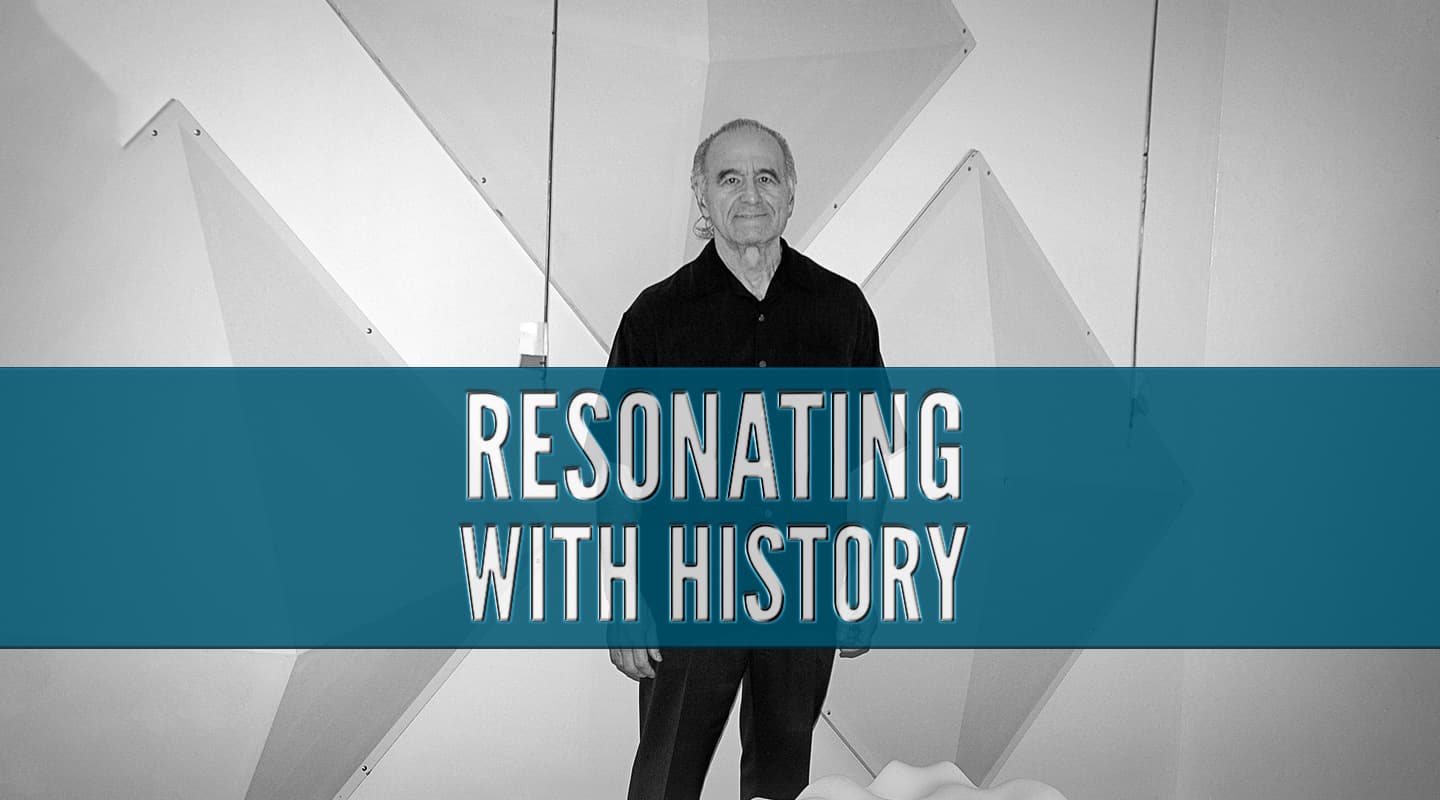
Resonating with History
Peter D’Antonio is the founder of RPG Acoustics, and has been instrumental in developing a diffusion coefficient standard that should help buying the right acoustic treatment easier. Unfortunately, it hasn’t quite tipped over into wide-scale adoption like his Reflection Free Zone control room design has. AudioTechnology quizzed D’Antonio on the latest acoustic design developments and the stunning Ambechoic design he and George Massenburg implemented at Blackbird studios.
Mark Davie: How did the diffusion coefficient come about, and what effect will the formalisation of that standard have on the future of acoustics?
Peter D’Antonio: When I founded RPG 30 years ago and introduced new diffusive technology, it was clear to me that we would have to provide education, successful examples and documentation of the application of this technology. The education began with presentations at the Audio Engineering Society in 1983 followed by over a decade presenting two or three times a year around the world. In addition, I have contributed over a hundred publications in peer review journals, magazines and books.
At the 84th AES in NY — following my presentation at a session in which Manfred Schroeder [the father of quadratic residue sequences – Ed] was, incidentally, the invited speaker — I met Don and Carolyn Davis of SynAudCon. They graciously invited me to a studio design meeting in Dallas, Texas, at which I presented my research to a group of emerging studio designers. Following that meeting, Don and Carolyn invited me to be a regular presenter at almost all of their meetings for several years. This provided me with an opportunity to educate a very large number of designers in the studio industry and incidentally, led to many years of lasting friendships.
As RPG evolved, I established a relationship with a brilliant acoustician named Trevor Cox, who is now Professor of Acoustics at Salford University. Trevor collaborated with RPG for several years during which we developed software for room dimension, speaker placement and shape optimisation among other things. We were invited to collate all of our research along with all that was currently known about the theory, design and application of acoustical absorbers and diffusors into a reference text book. This led to Acoustic Absorbers and Diffusers, Theory, Design and Application. We’re currently working on the third edition, with additional content. I have also provided several chapters in the Master Handbook of Acoustics by F. Alton Everest.
1940s
Monophonic playback in small control booths with no low frequency absorption. Most attention was given to large 15-30,000 square foot tracking rooms to accommodate large big band and symphonic orchestras.
1950s
Stereo began to slowly emerge and the non-symmetrical design of control rooms, poor monitoring conditions and speaker quality was becoming evident.
1960s
Stereo was where 5.1 multi-channel playback is today. Control room design became very important and designers like Tom Hidley, Phil Ramone and John Storyk emerged with various approaches and bass trapping to create rooms capable of auditioning multi-channel playback. Speaker technology also improved.
1970s
Philip Newell and Tom Hidley introduced the non-environment room with broad bandwidth bass trapping and flush mounted monitors. Dick Heyser introduced Time Delay Spectrometry, which led Don and Carolyn Davis to introduce the LEDE (Live End/Dead End) control room, which had an absorptive front and live rear.
1980s
Tom Hidley introduced 10Hz Infrasonic control room and surround-sound 5.1 monitoring. Neil Muncy designed LEDE rooms with all cone loudspeakers. George Massenburg employed a reflection rich zone control room, using front ceiling mounted quadratic diffusors and RPG introduced the RFZ/RPG control rooms offering a spatio-temporal reflection free zone and a diffusive passive surround-sound rear wall using number theoretic reflection phase grating diffusors.
1990s
The RFZ/RPG design proliferated and evolved along with other approaches, but no really new design emerged.
2000s
Floyd Toole presented research indicating that early reflections in small rooms may be beneficial to perception, an idea that was utilised by Massenburg and myself to create the Ambechoic control room design at Blackbird Studio C. New damped metal plate resonators, capable of providing absorption down to 40Hz in a thickness of four inches and the use of multiple in-phase subwoofers had a profound effect in controlling room modes.
2000s-Present
I haven’t seen much innovation in control room design, however, refinements in speaker technology, evolution beyond 5.1 to 7.x and improved acoustic materials have generally improved the quality of reproduced sound and envelopment. What was accomplished passively with the RFZ/RPG design, which was developed for stereo playback, is now being provided actively, however diffusion is even more necessary to uniformly scatter all of the direct sound coming from the speakers.
The successful examples began almost instantaneously, because what has become known as the RFZ (Reflection Free Zone)/RPG (Reflection Phase Grating) control room design was adopted enthusiastically by the studio design community and remains the de facto standard to this day. The first application was by Bob Todrank at the Oak Ridge Boys Acorn Studio in Hendersonville, Tennessee, followed by hundreds of major facilities worldwide. So these many examples demonstrated the efficacy of the design and the use of diffusion.
The last part involved documentation. In the early 1980s there was no standardised method to measure the performance of scattering surfaces, only the random and normal incidence absorption coefficient. I felt we needed to develop a standard so that an industry could be developed providing diffusive materials to the music industry and the general architectural acoustics industry. This began with full scale measurements using a Time, Energy & Frequency (TEF) analyser and a boundary measurement technique that I developed in which the diffusor was placed at the centre of a 5m-semicircle of microphones and a 10m-hemisphere containing a loudspeaker which emitted a stimulus signal. The signal was scattered by the diffusor and recorded by the microphones on the 5m-semicircle. When we ran out of large arena-sized venues to carry out full scale diffusion measurements, we developed a 1:5 scale measurement goniometer utilising 37 fixed microphones on a 1m-semicircle with the diffusor at the centre. The speaker semicircle was two metres from the sample. Along with this we developed an automated measurement process using a computerised protocol in which the computer directed the TEF to emit a Maximum Length Sequence (MLS) signal and a microphone switcher selected the respective microphone to record the impulse response. A data reduction procedure was developed to produce a diffusion coefficient. This became the topic of interest for the AES-4id-2003 publication, for a standards committee that I chaired. Following this, RPG co-funded an Engineering & Physical Sciences Research Council (EPSRC) program at Salford University to further refine the diffusion coefficient. More recently, we utilise 32 microphones and preamps to record the scattered sound on a workstation and deconvolve with the stimulus to obtain the impulse responses. This is extremely fast and takes no longer than an absorption coefficient measurement. In 2012 the diffusion coefficient was enshrined as ISO 17497-2, almost 25 years after we began our initial research!
Now what does this mean? Standards are important because they level the playing field. They help protect the consumer and the specifying acoustician. Everyone claiming to offer a particular product must provide proof-of-performance data to support their claims. This is true in the pro audio market for electronic gear like speakers, microphones, and absorptive materials. The diffusion coefficient standard hopefully will encourage manufacturers to publish diffusion coefficients as well for scattering materials. Most suppliers of diffusors are simply copying our original QRD designs. This is a shame, because the unsuspecting pro audio client who relies on magazine advertisements may not be aware that the original QRD is essentially a dinosaur in the annals of diffusor development. Figure 1 shows this 30-year evolution along with the diffusion coefficient improvement.
So the effect of formalising a diffusion coefficient provides a metric that allows acousticians and end users to characterise and choose among the various products on the market and filter out the noise. So far, RPG products are the only documented and widely adopted products in production to quote the diffusion coefficient standard. For the standard to have an impact, acousticians and end users must demand diffusor manufacturers provide the data. In this way, specifiers and end users will be protected. If the data are not demanded, internet and trade magazine hyperbole will be the governing metric as it currently is in the pro audio market.
MD: What new acoustic problems have you identified in the last 15 years that have required a new solution? And what do they stem from: shifting markets, people compromising in different ways, building materials?
PD’A: RPG’s initial market was recording studios and we hopefully had an impact on the evolution of studio design. One of the main reasons was that control room design was sorely in need of a scientific approach, based on acoustic and psychoacoustic research. We identified all of the potential acoustical problems and developed solutions. The physics of creating a neutral listening environment remain unchanged. At low frequencies, below say 200Hz, we’re dealing with wave acoustics and one has to address room modes and the speaker boundary interference. We developed programs, which are no longer available commercially, to optimise room dimensions and accurately locate loudspeakers to simultaneously minimise modal and speaker boundary issues.


2009
Modffractal

2004
Modffusor

1995
Diffractal

1983
QRD

Our Room Optimizer also demonstrated the benefit of using multiple in-phase subwoofers to further address modal problems, which Todd Welti and Floyd Toole’s research successfully extended to include multiple listening positions. Above 200Hz, we are dealing with geometrical acoustics and one has to address comb filtering and poor diffusion. The spatio-temporal RFZ addressed comb filtering and the RPG diffusors provided passive surround sound diffusion. The only thing that is new is implementing these issues to include multi-channel surround playback.
As the professional studio market migrated into project studios, RPG decided to focus its research and product development on general architectural acoustics and also added a noise and vibration line of products. As with the recording studio market when we entered it, the architectural acoustic market was in need of innovation, being heavily ensconced in acoustical ceiling tile and fabric wrapped panels. We are all familiar with the wide array of acoustically dysfunctional spaces like restaurants, airports, train stations, classrooms, etc., etc. In fact, most architectural spaces, as it turned out, could benefit from new designs and products that would fill a big commercial acoustic void. Because of our strong relationship with acousticians, based on our numerous publications, presentations and research laboratory, we were able to make important contributions and introduce a wide array of new products.
With respect to diffusion, we evolved the original QRD to Modulated Optimised Diffusor (MOD) and introduced optimised curvilinear diffusive shapes, using our proprietary Shape Optimiser software. These new surfaces were enthusiastically adopted by the architectural community and provided entry into museums, auditoria, performing arts facilities and schools, as well as recording studios. We also developed the RPG Absorbor System, consisting of a wide range of new absorptive tools, including microperforated wood, Topperfo Micro, transparent/translucent microperforated and microslit foils and panels, recycled stone and glass, acoustical CMU and evolved the traditional fabric wrapped panel to provide broad bandwidth absorption, in the form of the multi-layer Broadsorber, dedicated low frequency absorption, Modesorber, and a new line of transparent acoustical fabrics called SoundGem.

MD: Being able to measure, interpret and specify is still the fundamental skill of the acoustician that home studio engineers are unable to emulate. Do you think there will be a game changer that will alter that dynamic in the future?
PD’A: I think there will always be a need for a professional in any field. While there are many self-diagnostic medical sites, like WebMD, which help educate people to diagnose symptoms and possible remedies, a visit to your doctor is still a good idea. While the RPG Diffusor System and all of the pro audio acoustical products that followed our lead over the past 30 years provide a definite improvement to the home studio, there are many issues that still can benefit from a professional studio designer. Designing a home studio is more involved than hanging some foam/fabric wrapped fibreglass absorbers and undocumented diffusors on the wall. Foam or fabric wrapped absorbers should be 4-inches thick or greater. The problem with thin absorbers is that they act like turning the treble control of the room down. The room loses all of its ambiance and brilliance and low frequency problems can be accentuated. All acoustical treatment should be broad bandwidth like an all-pass filter rather than a low-pass filter. Foam corners are also questionable, since the particle velocity is zero in corners. Room dimensions, speaker positioning and tuning, subwoofer placement and number, diaphragmatic nature of wall and ceiling boundary materials, noise and vibration control (isolation and HVAC), lighting, acoustical placement, console reflections, room modes/speaker boundary interference, frequency response, transferability, etc. all need to be acoustically measured and sonically evaluated.
MD: How did you come up with the Ambechoic design, and why is it more or less desirable than other designs?
PD’A: The Ambechoic design concept essentially provides a uniform acoustical environment in rooms which utilise active surround sound, as opposed to the RFZ/RPG design which was a solution to address stereo playback, utilising passive surround diffusion. The idea came to fruition when I received a call from George Massenburg who was working at Blackbird Studios in Nashville. George had previously experimented with a reflection rich design approach using number theoretic diffusors at the Complex in West Los Angeles, CA years ago and wanted to create a massively diffusive, proof-of-concept, neutral control room environment with improved imaging of virtual sources in surround monitoring, a much broader ‘sweet spot’ and supportive, linear ambiance that had near-equal decay rates across as much of the frequency spectrum as possible. The experiment involved designing a single period, 3-foot deep amplitude modulated, 2D-optimised primitive root wall diffusor with 138,646 individual block heights, which extended around the entire perimeter of the room. In addition, we developed a 7-foot deep primitive root Diffractal with 27,336 block heights extending down to 50Hz on the ceiling. The corners of the room were treated with metal resonator low frequency absorbers which absorbed efficiently down to 40Hz in a thickness of four inches. I can vividly remember returning from dinner on the day we carried out acoustical measurements to audition the latest re-mastered Dark Side of the Moon and were completely astonished at the incredible enveloping sound stage. The concept was proven! In the original RFZ/RPG design there was a clear demarcation between the anechoic front and diffusive rear of the room. With today’s multi-channel surround loudspeaker designs, having a uniform acoustical environment surrounding the listener seems and sounds more natural. Engineers and end users have become accustomed to an absorptive environment surrounding the loudspeakers and so it will take some exposure to a uniform environment for people to evaluate.
MD: We’ve seen acoustic room design principles like Live End Dead End and Reflection Free Zones be adopted in the mainstream. What would it take for Ambechoic designs to be widely adopted?
PD’A: Not too much really. We developed the RFZ/RPG design for stereo playback. The rear wall diffusors provided essentially passive surround sound, though we didn’t call it that at the time. Today, we are privileged to enjoy active surround sound. While many prominent studios, like Gateway Mastering in Portland, have evolved the RFZ/RPG design to address surround, it occurred to me that we could also evolve the design of multi-channel rooms. One of the tenets of the RFZ is to remove early reflections so that they don’t cause comb filtering and corrupt the spatial and spectral character of the playback. My background in research has taught me to always look at the boundary conditions when searching for a solution. For a control room design, we can look at the extremes of an anechoic chamber and a reverberation chamber. If you have had the opportunity to audition music in either, you know neither will do. Therefore, in the RFZ approach we chose an anechoic area surrounding the mix position and diffuse (reverberant) sound arriving from the rear wall mounted RPG diffusors. Another approach could have been to select a reflection rich zone surrounding the mix position, with many early reflections combining with the direct sound. Much psychoacoustic research has been done to support the idea that when you have a large number of early reflections the comb filtering may not be a problem.
We had a saying when we were helping shape studio design many years ago, ‘If you can’t take the room out of the mix, you can’t take the mix out of the room
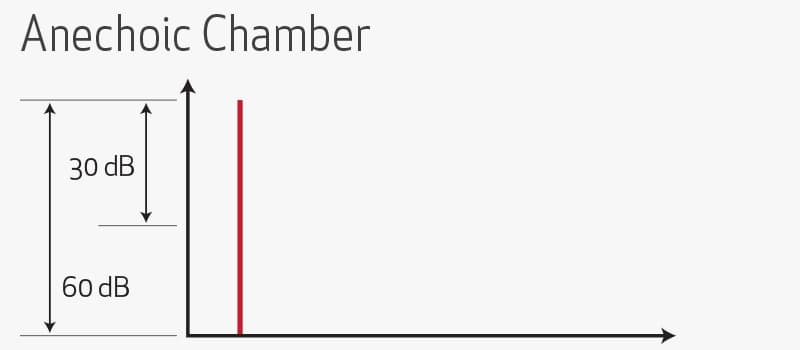




The Energy Time Curves (ETC) at the mix position of various control room designs with direct sound (red) and diffuse reflections (blue). The Ambechoic design at Blackbird Studio C (right) brings forward the diffuse reflections with a 0.3s delay time to the noise floor.
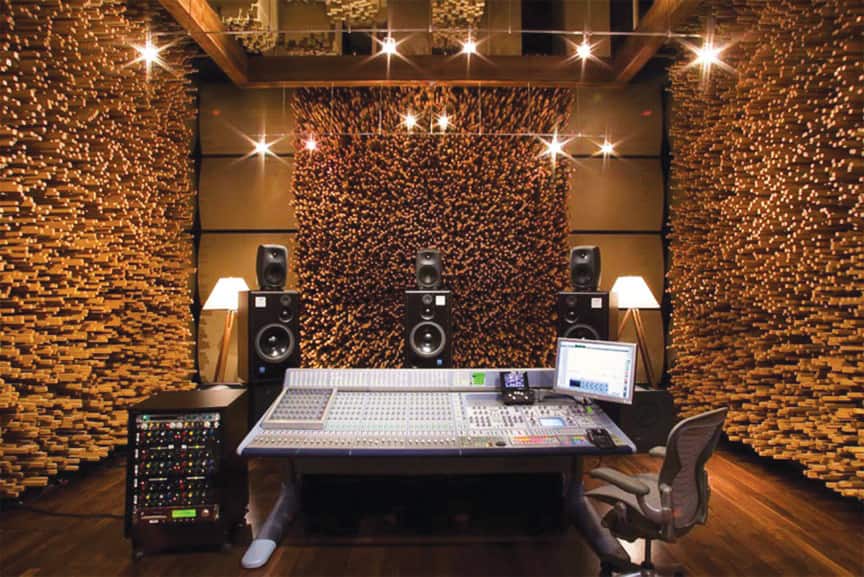
Or one can go a step further and utilise low-level diffuse reflections, down roughly 20-30dB, on all surfaces of the room providing an enveloping uniform acoustical environment, thus creating an Ambient Anechoic or Ambechoic environment, as was shown to be successful at Blackbird Studio C. This design is quite straight forward. Utilise broad-bandwidth, two-dimensional diffusors on the mid-third area of all walls and ceiling between the speakers and mixing/producer area and low frequency metal resonators, reaching down to roughly 40Hz, in the four corners. It also helps to use multiple in-phase subs in corners or wall mid-points.
Therefore, the idea of a balanced design becomes a possibility, in which we don’t have the dichotomy of a live end and a dead end; we have uniform surround sound. Now the RFZ/RPG approach and modified RFZ/RPG for surround sound has been popular and successful for many years, so it will take a while for engineers and end users to audition Ambechoic-designed rooms. While we have introduced the scientific approach to control room design, music preference is still subjective. I assume there will be those that like the RFZ approach and others that prefer the Ambechoic approach, so time will tell. To properly implement the Ambechoic design, the diffusors should be broad brand, at least four inches deep or more and preferably 2D designs, which scatter omnidirectionally. The idea is that we need many low level diffuse reflections and 2D surfaces provide roughly twice the attenuation of a 1D diffusor in a given direction. The corner bass absorption should extend to 40Hz using metal plate resonators. Many of the so-called bass traps on the market are merely thick fibreglass spaced from the boundary to improve low end performance. But people should realise that the absorption mechanism for porous absorption by foam, fibreglass and other porous materials is particle velocity. This means that absorption efficiency is maximised when the porous material is located where the particle velocity for a particular frequency is a maximum, at a quarter wavelength — the particle velocity at a boundary surface and in a corner is zero! Therefore, placing porous materials on a boundary and in a corner is not a very efficient idea. Resonators are maximally efficient when the pressure is a maximum. Therefore, utilising plate resonators or membrane absorbers in a corner is much more efficient than porous materials.
MD: How do you define what you’re trying to achieve — either in measurements or descriptive terminology — when you’re altering the acoustics of a space? Has that changed over the last 15 years?
PD’A: When I entered the acoustics industry, Dick Heyser’s Time Delay Spectrometry and Energy Time Curves (ETC) were just being introduced to measure room acoustics. After being exposed to this powerful approach, I embraced it enthusiastically and used it to develop control room designs, the diffusion coefficient and innovative diffusive products. Today, there is a plethora of computer-based room acoustic tools utilising swept sine waves, MLS, etc. I currently use the EASERA platform, which offers a complete array of stimuli and processing techniques. So I would have to say room acoustic measurements have definitely gotten a lot easier to carry out and process.
With respect to design metrics, they vary in the different spaces acousticians have to deal with. I typically divide spaces into speech rooms, music performance, music audition and multi-purpose spaces.
In speech only spaces, like classrooms, lecture halls, meeting/conference rooms or any space in which information is transferred, the goal is a high signal to noise ratio (SNR), in which the signal is the direct sound and the noise is everything else, including external intrusion, HVAC noise, occupant noise and reverberation. The solution is to increase the early reflections to temporally fuse with the direct sound increasing the signal and reducing the noise. This can be measured by determining the ratio of early-to-late energy in the room impulse response or various speech indices, like Speech Transmission Index based on the modulation transfer function, Rapid STI, %ALcons, etc., which are easily measured.
In performance spaces, the acoustics industry has determined a long list of objective measures which correlate with subjective preference in the audience. These include metrics like reverberation time and early decay time, clarity (C80), which is the ratio of early-to-late energy, envelopment which is based on the late Inter Aural Cross Correlation (IACC), spaciousness or early IACC, Loudness, Gmid (room gain based on sound levels at mid frequencies) and a host of others. All are easily measured from the room impulse response. Typically many locations have to be evaluated, but multi-microphone techniques have reduced the time involved. For a performing musician, whether on stage or in a rehearsal room, the acoustics must provide ensemble reflections so they can hear one another and play in synchronicity. Also musicians need support to determine tone, intonation and loudness.
Then you have control rooms or neutral listening environments, where the goal is to audition recorded information and be able to perceive spatial and spectral information to balance and signal-process multi-channel information into a final product. While reverberation time is often mentioned in describing these rooms, typically the sound field is reduced below the noise floor if you are measuring 60dB of attenuation. And so it is more correct to consider the decay time of several hundred milliseconds. However, in these small rooms this is rarely an issue. The primary metric in these rooms is the steady state frequency response. It should be flat! No modal emphasis or speaker-boundary interference. The room should be symmetrical to audition the soundstage. Envelopment or immersion is also important and can be determined from Directivity diagrams (‘hedgehog plots’) which illustrate the spatial distribution of distinct specular and smooth diffuse sound incidence. This can be measured with oriented cardioid microphones or newer spherical arrays. If the room is not neutral, engineers wind up listening to their mixes in their cars, on small speakers, large speakers, boom boxes, mp3s, ear buds, etc. You must be able to trust your room, so you can take your mix out of your room.



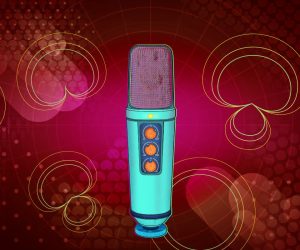



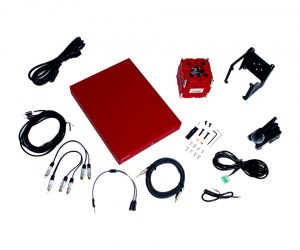
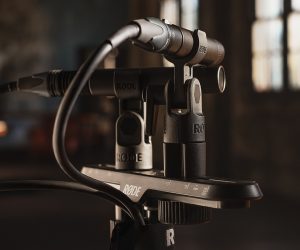
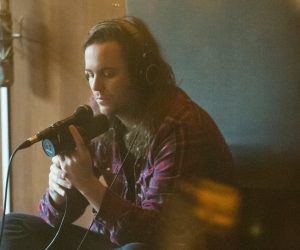






I never took into account the fact that the successful instances started almost immediately since the RFZ (Reflection Free Zone)/RPG (Reflection Phase Grating) control room design was quickly accepted by the studio design community and has remained the de facto norm to this day. I remember when I was a college student I was proudly answering the question but now I realize it was different. Thank you for helping me understand the right information about RPG diffusor systems.